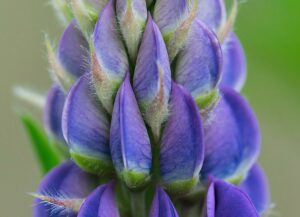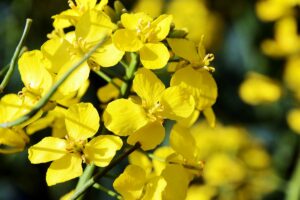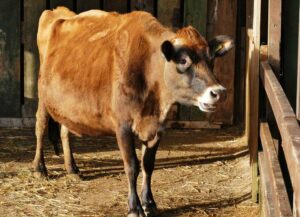Juan I. Sánchez Duarte, David G. Reta Sánchez, Jorge A. Granados Niño and Esmeralda Ochoa Martínez
One of the problems associated with silage quality in dairy farms is pre-harvest frost damage of corn plants. Late planting during spring and/or summer causes corn to not attain optimum physiological maturity for silage making and to be affected by low seasonal temperatures.
Although there are options to cope with this situation, it is necessary to know the effects of frost on corn, the quality and feeding purpose of the silage and some possible alternative solutions on the farm.
Plant injury or death due to frost
While cool temperatures affect all plant metabolic and physiological processes, the main mechanism that occurs at low temperatures is the formation of lipid crystals in cell membranes. This mechanism increases the permeability of the membrane, affecting the balance of solutes, ions, and protons in the cell, and thus disrupting its enzymatic activity.
The degree of frost damage depends on the absolute drop in temperature, the duration of the event, and the stage of corn development when the frost occurs.
Temperature
When air temperatures drop to 0°C for 4-5 hours or to -2°C for only 5-10 minutes, the corn plant dies or there can be severe damage to the stem leaves, and sheath. Under these conditions, no photosynthesis or carbohydrate mobilization occurs in the plant.
If the temperature remains between 0°C and 4°C for 1-2 hours during the grain filling stage, the corn leaves may die, but not the stem or sheaths. This causes carbohydrates stored in the stem to move towards the grain to help slightly in its filling.
Stage of corn development
With regards to the stage of crop development, if the frost occurs when corn reaches the milk stage, and the plant appears to be completely dry since the leaves are dry. The moisture content in the plant however is still very high to adequately ensile.
Similarly, if the frost happens when the crop reaches the stage of full grain, the plant also contains too much moisture; as a result, it is not advisable to harvest and ensile immediately at this stage.
When the frost damage happens in mid- or late-stage maturity, the plant moisture content (65-70%) is closer to the optimum for good fermentation so it is advisable to harvest and ensile immediately.
In any of these cases, there could be losses of yield and nutritional quality before ensiling.
Losses of yield and nutritional quality
Potential field losses in nutritive value of corn plants due to freezing depends on the severity of the frost and the stage of crop development at the time:
- If the frost destroys only the leaves during the growth stage of corn filling, the process could be completed, since there are still carbohydrates being mobilized to fill the grain.
- If the frost was severe and the crop in a more advanced stage of maturity, then grain losses are not that significant.
This is an important point to consider since the cob contributes significantly to the yield and overall quality of the silage.
A two-year study conducted in Canada2, estimated the damage in the corn plants during the milk stage. After a frost of between 0°C and 1°C, there were yield and grain DM losses of 9.5 and 2.7 t/ha, respectively (figure 1). In addition, this study also revealed that up to 39% of the total carbohydrates available in the entire plant were lost. These losses are not devoid of problems since it will affect silage fermentation since carbohydrate fermentation is critical for lactic acid bacteria to drop pH.
 Figure 1. Forage and grain yield losses after a frost between 32 and 34°F in corn for silage harvested between the end of September and the beginning of October (Can. J. Plant Sci. 1976, 56:481-486)2.
Figure 1. Forage and grain yield losses after a frost between 32 and 34°F in corn for silage harvested between the end of September and the beginning of October (Can. J. Plant Sci. 1976, 56:481-486)2.
Damage to the different plant parts post-frost will negatively affect the nutritional quality of the forage to ensile, and this quality will be reduced as the period from frost to harvest is prolonged.
The researchers2 showed that delaying corn harvest for forage after a frost between 32 and 34°F decreases DM digestibility and increases cellulose concentration in the forage (figure 2). This is due to the damage suffered by the most digestible plant parts, such as for example the leaves.
Other factors that have an effect are the stage of crop development when the frost happens, and how the forage is managed after freezing, will both influence fermentation and silage quality.
 Figure 2. Average dry matter (DM) digestibility and cellulose content in corn forage harvested at intervals of 10 days after a frost of 37°F (Can. J. Plant Sci. 1976, 56:481-486)2.
Figure 2. Average dry matter (DM) digestibility and cellulose content in corn forage harvested at intervals of 10 days after a frost of 37°F (Can. J. Plant Sci. 1976, 56:481-486)2.
Fermentation and nutritional quality of silage
Silage fermentation
Silage fermentation is affected if frost damaged the corn crop. Ensiling corn immediately after frost damage when at an early growth stage, will result in excessive seepage from the silo since its moisture content is too high. This runoff is a sign of bad silage fermentation and represents nutrient losses through the liquid that drains from the silo. In addition, there will also be more DM losses from the silo during fermentation, and the silage will heat at feed-out.
Low temperatures decrease the efficiency of forage fermentation in the silo by reducing the growth rate of microorganisms and enzymatic activity; which are essential to preserve forage.
A study by Canadian and US researchers measured the efficiency of corn forage fermentation at different temperatures showing negative effect of the lowest temperature (5°C) on the fermentation parameters in the silage. The number of lactic acid bacteria (LAB) decreases when the silage ferments at lower temperatures. This causes little production of lactic acid and, therefore, the pH in the silage is high.
Other products of fermentation in the silo, such as acetic acid and ammonia nitrogen, are also affected at low temperatures (figure 3). In places where the temperature continues to be very low after ensiling, the fermentation cannot improve, since the silage will remain frozen. However, in places where the temperature is temperate to warm, silage fermentation can improve by increasing the microbial activity in the silo.
 Figure 3. Effect of temperature on fermentation in corn forage (J. Appl. Microbiol. 2016, 121:657-671)3.
Figure 3. Effect of temperature on fermentation in corn forage (J. Appl. Microbiol. 2016, 121:657-671)3.
Nutritional quality of corn silage
The nutritional quality of processed corn silage from the frost-damaged corn will also be affected. The silage DM content depends on the time elapsed between freezing, compacting, and sealing the forage in the silo. If the compaction happens immediately after the frost, the silage DM content will be very low.
The concentrations of silage fiber and lignin are higher in frost-damaged corn forage compared to one not affected. The inclusion of silages with high fiber and lignin in the diets can limit DM intake in dairy cows, and probably reduce milk production and composition.
Dairy cow performance
There is little information on the effects of including frost-damaged corn silage in the diets and the performance of lactating dairy cows. It is hard not to think that a corn silage with leaves, stems and ears that have been damaged by frost, or that resulted in a poor fermentation in the silo, could have a positive effect on cows.
Researchers from Quebec1, Canada, evaluated the addition of corn silage harvested in the milk stage fed to dairy cows, which was damaged by one, and up to six freezing events. The authors found that cows fed damaged silages, slightly reduced the digestibility of DM, raw energy, nitrogen and fiber (table 1).
Cows that received diets with frost-damaged silages slightly decreased their DM intake. Consequently, there were expected live weight losses, and slight reductions in the production and percentage of milk fat, compared to cows that received a diet with corn silage not affected by frost (table 1).
Table 1. Nutrient digestibility and performance of dairy cows fed diets containing corn silage affected by frost (J. Dairy Sci. 1983; 66:1466-1473)1.
| Corn silage diet
before frost |
Frost-damaged corn
silage diet |
|
| Nutrient Digestibility (%) | ||
| Dry Matter (DM) | 64.4 | 63.0 |
| Gross energy | 66.6 | 64.4 |
| Nitrogen | 58.4 | 53.8 |
| Neutral detergent fiber | 57.6 | 56.6 |
| Calcium | 38.0 | 42.3 |
| Phosphorous | 33.4 | 33.4 |
| Cow performance | ||
| DM intake, kg/day | 15.7 | 15.4 |
| Body weight gain, kg/day | 1.20 | -2.00 |
| Milk, kg/day | 18.0 | 17.6 |
| Milk fat, % | 3.55 | 3.30 |
| Non-fatty solids, % | 8.70 | 8.87 |
Implications
Although it seems complicated to deal with frost-damaged corn, and to make the best management decisions after the frost occurred, and the use of this silage in livestock, there are potential alternatives to prevent and/or solve this problem on the farm.
- Good planning for timely spring and/or summer cultivation allows the farmer to prevent the corn cycle from extending and approaching the autumn-winter frosts. This is easier said than done however, in farms with extended planted acreages.
- Sowing in dry soils can shorten the harvest approximately 10 to 12 days; although this depends on soil texture. It is very advisable to work close to an agronomist in order to be aware about the implications and disadvantages of sowing in dry soil.
- Using early corn hybrids and accurately monitoring the occurrence of frost in the region can help make proactive farm decisions. Always make sure that the precocity of these hybrids has been tested experimentally for the region.
- Once frost occurred it is necessary to accurately estimate the DM content of the forage. If the corn was in an early developmental stage, it will be necessary for it to remain in the field for a few more days, until it reaches the desired dry matter concentration (30-35%). It has to be understood that although needed, the nutritional quality of silage can suffer if it remains on the field for too long.
- The particle size of the forage may be altered as a result of the DM content of the corn silage. It is thus imperative to also check the length of the forage chopped at harvest time. Always keep in mind that an optimum forage particle size before ensiling not only ensures proper compaction and fermentation in the silo but also prevents metabolic disorders in cows and problems with milk fat.
- Although there is little research on the use of microbial inoculants in frost-damaged corn silage, it is always advisable to use one that contains L. buchneri since it can prevent excessive DM losses and improve silage stability at feed-out.
- It is advisable to analyze frost-damaged silages once they are opened. The analysis should include dry matter, protein, fibers and energy (mainly starch). Also, it is also important to know at least the silage pH (not just estimated with NIR). The latter will give at least an idea of the type of fermentation in the silage. It is also important to include the concentration of nitrates, since under stress conditions plants tend to accumulate them. This is important in spite of the fact that silage fermentation can reduce them up to 50%.

Figure 4. Corn forage of a summer production cycle after 2 days of being affected by a frost of 25.2°F between November 14-15, 2018 in Matamoros, Coahuila Mexico.
About the authors
Sánchez Duarte is a researcher in dairy cattle nutrition and forage quality. Reta Sánchez is a researcher in crop physiology. Ochoa Martínez is a soil fertility researcher. They work in the INIFAP-CIRNOC-CELALA of Matamoros, Coahuila, Mexico. Granados Niño is a professor-researcher in forage production at the FAZ-UJED in Venice, Durango, Mexico.
References
- St-Pierre, N.R., R. Bouchard, G.J. St-Laurent, C. Vinet, G.L. Roy. 1983. Effects of stage and frost on nutritive value of corn silage for lactating dairy cows. Journal of Dairy Science. 66:1466-1473.
- White, R.P., K.A. Winter, H.T. Kunelius. 1976. Yield and quality of silage corn as affected by frost and harvest date. Canadian Journal of Plant Science. 56:481- 486.
- Zhou, Y., P. Drouin, C. Lafreniè 2016. Effect of temperature (5-25°C) on epiphytic lactic acid bacteria populations and fermentation of whole plant corn silage. Journal of Applied Microbiology. 121: 657-671.











